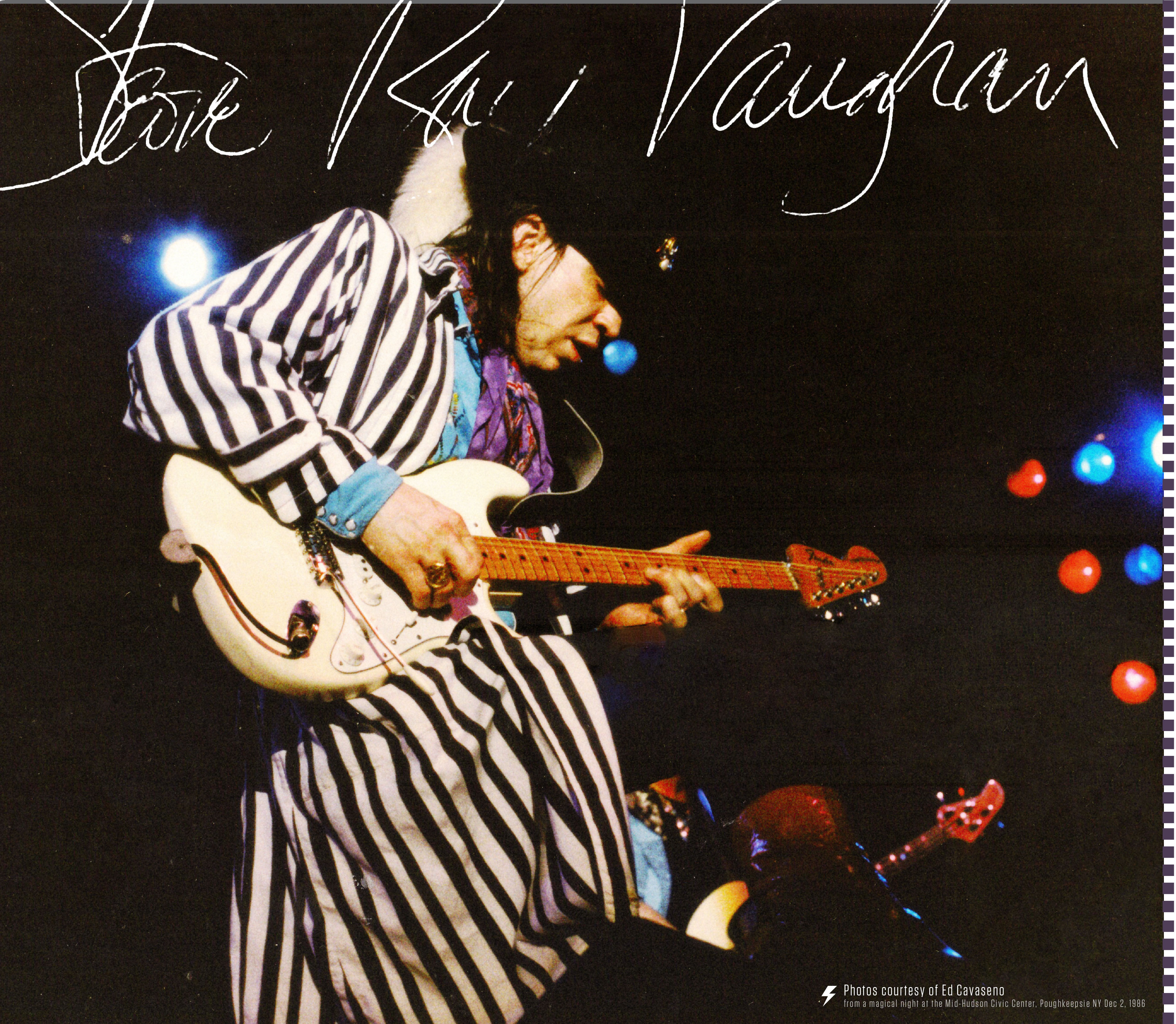With Herculean chops, a thunderous sound and Texas hurricane-sized soul, the late Stevie Ray Vaughan turned the world on its ear with his blistering blues guitar virtuosity. Back in 1983 — a time when the charts were dominated by the lightweight pop sounds of Lionel Richie, Men At Work and Culture Club — Stevie Ray blasted out of Austin, Texas for his momentous debut on David Bowie’s multi-platinum, Let’s Dance, lending smoldering guitar work to several tracks.
From the very first notes of Stevie’s Albert King-inspired solo on the title track, it was clear that this was no L.A. session rat. Brutally huge bends were punctuated by sharp stabs and heaven-sent vibrato — on a disco track, no less. It was immediately clear: there would be no turning back. SRV’s playing on Let’s Dance set ablaze a firestorm of intrigue about this soon-to-be legendary guitarist.
Released later that year was the essential Texas Flood, Stevie’s debut with Double Trouble (Tommy Shannon, bass, and Chris Layton, drums). Stevie Ray Vaughan’s passionately intense guitar playing quickly positioned him as the most vital blues guitar voice — the spearhead — of a new generation.
I was fortunate to have had the opportunity to interview Stevie Ray four times — more times than I’ve interviewed any other guitarist. The first three times were with him alone; the fourth time was with his brother, Jimmie, at the time when their Family Style album was about to be released.
During most of these interviews, Stevie would play my beat-up 1961 Strat — a guitar very similar to his beloved “No. 1” Strat — the entire time, punctuating his thoughts with little musical statements. He told me more than once that he loved the guitar, and I think the feeling was mutual. Essential to interviewing Stevie was to delve into his playing, and he was always more than happy to share his secrets and insights into the elusive art of blues guitar.
The following interview took place on June 23, 1989, at the Epic Records offices in NYC at the time when Stevie’s smash hit In Step was just about to be released. The soon-to-be FM staples “Crossfire,” “Tightrope” and “Riviera Paradise” were yet to be played on the radio, so we were able to speak about these tunes without the influence of knowing just how successful these songs would soon be.
INTERVIEW EXCERPTS
AA: How did you develop your soloing style?
SRV: It’s a real weird mixture. It’s kind of everything from my generation to Muddy Waters at the same time. It goes back to my brother Jimmie, when he was bringing home all these different records. It might have been because I was a little kid, but it seemed like, all at the same time, he brought home The Bluesbreakers with Eric Clapton, Howlin’ Wolf, B.B. King, Muddy Waters and the Beatles. It was like, “Here comes Jimmie with the record world!” [laughs]
AA: The whole history of recorded music was under his arm!
SRV: Yeah! And he knew what he was doing. At the same time, there were these friends of my parents whose son came over with his guitar, and he’d show us Jimmy Reed stuff, Ray Sharpe and the Razorblades. Here’s all this going on, and then somewhere real soon down the line, Jimmie brings home this Jimi Hendrix record, and we both went, “AHHHH! What’s this?!”
___
SRV: By the time I was 12 years old, Jimmie was gone. Here he was, the hottest guitar player I knew of, and was considered the hottest guitar player in Texas at age 15. I think he started playing when he was 12. I mean, what do you do but get excited when all this is going on? If you want to know what made me go crazy with it, it was watching him, and, not trying to out-do Jimmie, but, shit, what do you do but pick up the ball and run? It’s not trying to pass him, and it’s not trying to keep up with him. It’s more like, “Wow! Look what big brother stumbled onto!” A lot of people seem to think that we’re trying to beat each other at something, but it’s not that at all. I saw him get real exciting — not just excited, but exciting — with something, and that excited me. I didn’t know what else to do!
___
AA: What were some of the slow blues that you listened to that helped you in developing your style?
SRV: Albert King records, for one thing. B.B. King’s Live At The Regal, Albert King’s Born Under A Bad Sign, it was called first, or King Of The Blues Guitar. Believe it or not, I remember seeing Albert King on TV, doing “Born Under A Bad Sign,” when I was a kid, and I was like, “YES!!!”
DIALING IN STEVIE’S TECHNIQUE
LESSON: “Among the great many attributes that comprise Stevie’s Ray’s talent as a guitarist, it is his complete mastery of the blues idiom that resides at the core. Stevie’s instantly identifiable sound is built from an assimilation of T-Bone Walker, Albert, Freddie and B.B. King, along with elements of many others blues masters. In my Slow Blues Power DVD, I take an in-depth exploration of the SRV approach to slow blues in the chapter entitled, “Flood Blues in G.”
LESSON: “Stevie Ray’s absolute dedication to pure blues did not dissuade him from exploring other sounds and, ultimately, pushing the boundaries of blues and blues/rock music into uncharted territories. IN my Progressive Blues Power DVD, it is my goal to illustrate a solid foundation of the blues and then build upon that foundation to the more “progressive” sounds of Jimi Hendrix, Jeff Beck, Johnny Winter, and Stevie Ray Vaughan as well.”



